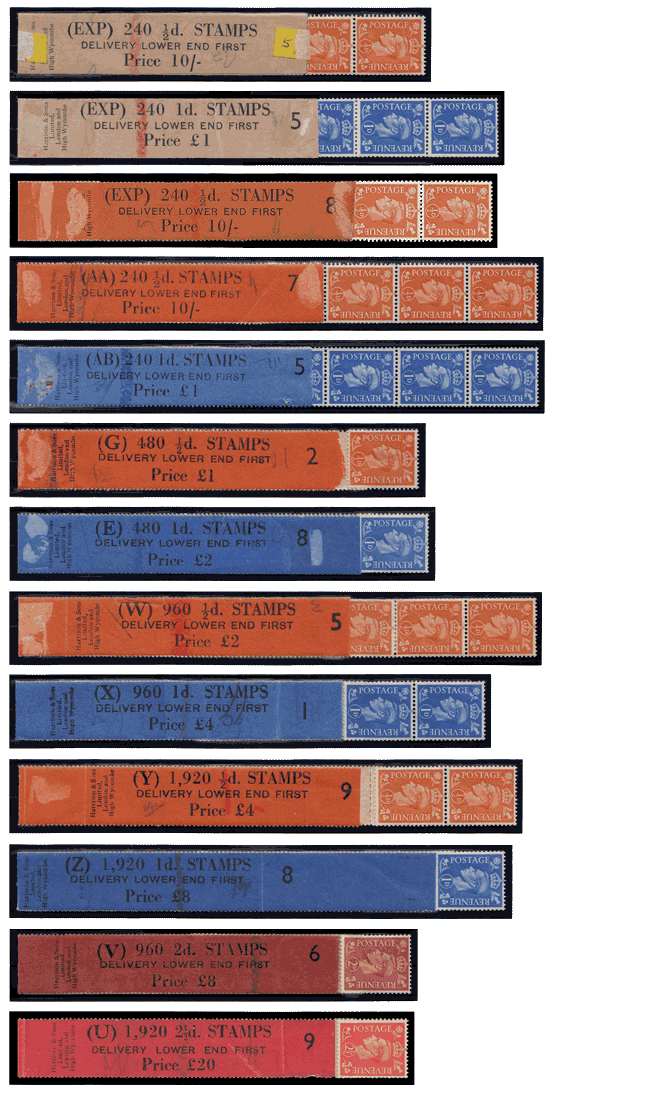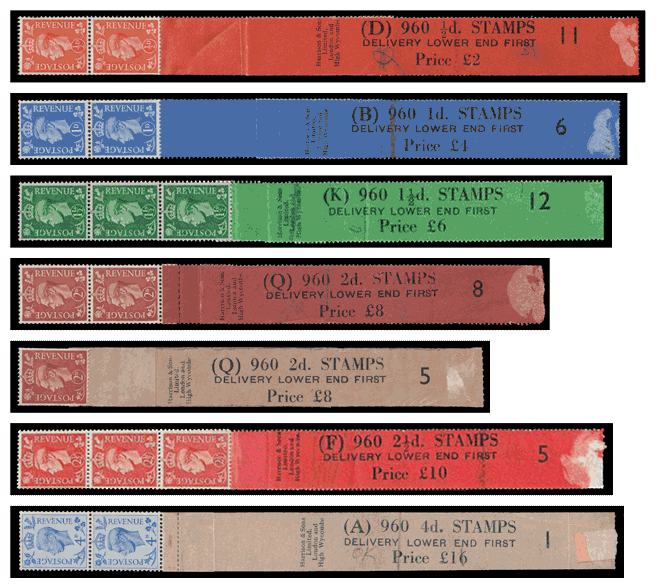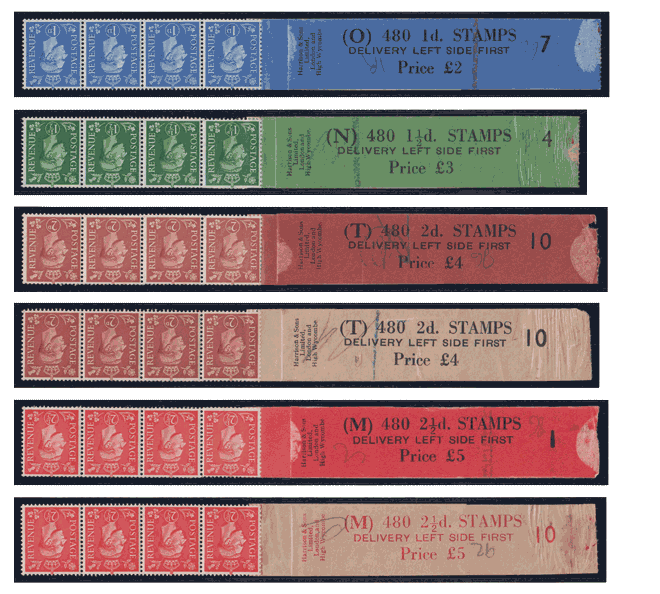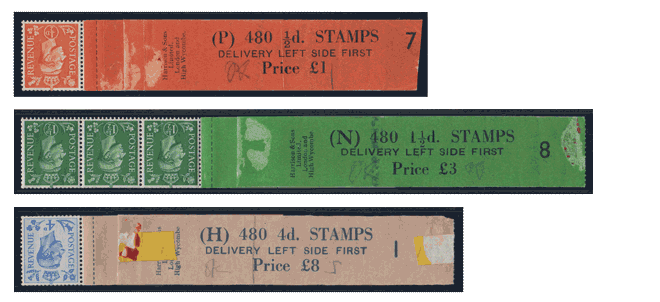
Stamps printed in new or changed colours were introduced in 1950-1951 to meet Universal Postal Union regulations. The 4d stamp was issued first in Oct 1950 due to an increase in the Foreign Letter Rate from 3d to 4d and (AH) rolls were issued in the same month (earlier rolls lettered (AH) had been discontinued in 1920). The ½d to 2½d were issued to coincide with the opening of the Festival of Britain on 3 May 1951. There was no change of colour for the 3d or 6d stamps, hence no (CJS) rolls are listed in New Colours.
Leaders for all rolls, other than buff ones, were in bright colours on white paper with a Harrison watermark, either upright or inverted across the leader, or along the leader on some (P) rolls. (Wilding (P) rolls have the watermark along the leader, but this issue exists both across and along.) Bright coloured leaders for endways delivery were perforated gauge 14.

Perforated gauge 14 with watermark “Harrison & Sons, London” as seen from the front.

Imperforate (P) roll with watermark along the leader as seen from the front.
| A | 4d | 960 | £16 | Lower End | Buff | 20 |
| H | 4d | 480 | £8 | Left Side | Buff | 12 |
| B | 1d | 960 | £4 | Lower End | Blue/White | c |
| D | ½d | 960 | £2 | Lower End | Orange/White | c |
| E | 1d | 480 | £2 | Lower End | Blue/White | c |
| F | 2½d | 960 | £10 | Lower End | Red/White | c |
| G | ½d | 480 | £1 | Lower End | Orange/White | c |
| K | 1½d | 960 | £6 | Lower End | Green/White | 20 c † |
| L | 1½d | 480 | £3 | Top End | Green/White | 20 c † |
| M | 2½d | 480 | £5 | Left Side | Red/White | csw |
| N | 1½d | 480 | £3 | Left Side | Green/White * | 12 csw † |
| O | 1d | 480 | £2 | Left Side | Blue/White | csw |
| P | ½d | 480 | £1 | Left Side | Orange/White | 12 |
| Q | 2d | 960 | £8 | Lower End | Brown/White | 20 c ‡ |
| R | 2d | 480 | £4 | Top End | Brown/White | 20 c ‡ |
| T | 2d | 480 | £4 | Left Side | Brown/White | csw |
| U | 2½d | 1,920 | £20 | Lower End | Red/White | c |
| V | 2d | 960 | £8 | Lower End | Brown/White | 20 c ‡ |
| W | ½d | 960 | £2 | Lower End | Orange/White | c |
| X | 1d | 960 | £4 | Lower End | Blue/White | c |
| Y | ½d | 1,920 | £4 | Lower End | Orange/White | c |
| Z | 1d | 1,920 | £8 | Lower End | Blue/White | c |
c: continuous csw: continuous sideways 12/20: strips
* green/white, then dull green/buff.
† continuous 1½d rolls from Sept 1951 (PPR increased to 1½d).
‡ Langston & Corless state that continuous printing of 2d rolls was adopted late in 1951; however, Post Office records show that continuous 2d pale red-brown endways rolls were issued in May 1951.
| M | 2½d | 480 | £5 | Left Side | Buff | csw |
| N | 1½d | 480 | £3 | Left Side | Green | csw |
| Q | 2d | 960 | £8 | Lower End | Buff | c † |
| T | 2d | 480 | £4 | Left Side | Buff | csw |
† not listed by Langston & Corless.
Experimental rolls for vending machines in exposed places were introduced in Feb 1952 (EXP being an abbreviation of “exposed” rather than “experimental”). They were replace by (AA) and (AB) rolls when the smaller size was adopted in 1954.
| EXP | ½d | 240 | 10/- | Lower End | Buff | c |
| EXP | 1d | 240 | £1 | Lower End | Buff | c |
| EXP | ½d | 240 | 10/- | Lower End | Orange/White | c |
| EXP | 1d | 240 | £1 | Lower End | Blue/White | c |
| AA | ½d | 240 | 10/- | Lower End | Orange/White | c |
| AB | 1d | 240 | £1 | Lower End | Blue/White | c |
Stamp Vending Machines
Rolls for use in Post Office vending machines (EXP, AA, AB, GEWXYZVU) have 240, 480, 960 or 1,920 stamps wound lengthways, facing inwards, onto ¾” diameter cores, for delivery lower end first.

POKO Affixing Machines
Rolls for use in POKO affixing machines (DBKQFA) have 960 stamps wound lengthways, facing outwards, onto 1¼” diameter cores, for delivery lower end first.

FIXO Affixing Machines
Rolls for use in FIXO affixing machines (LR) have 480 stamps wound lengthways, facing outwards, onto ½” diameter cores, for delivery top end first.

Multipost Affixing Machines
Rolls for use in Multipost affixing machines (PONTMH) have 480 stamps wound sideways, facing outwards, onto ½” diameter cores, for delivery left side first.
Continuously printed, watermark sideways (ONTM):

Made from strips of 12, watermark upright (PNH):

Next: KGVI Experimental Rolls